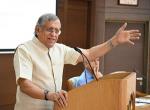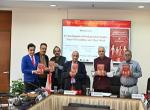While the jury may still be out debating whether India’s economy has really taken off under the new political dispensation in New Delhi, members of the VIF faculty, General NC Vij, Director VIF, Amb PP Shukla, Adm KK Nayyar, among others, engaged T.N Ninan, the distinguished journalist and author of ‘Turn of the Tortoise: The Challenge and Promise of India’s Future’ on December 2, 2015 in a penetrating interaction, focusing on the state of economy and what the future potentially holds for India, especially in terms of developmental aspirations. The interaction, a spin off from the book, threw some new light on India’s economy while propping up fresh ideas to catalyse it in tune with our growth objectives.
 In his opening statement, General Vij said, the world’s attention remains riveted on India doing reasonably well on the economic front, a statement not only backed by Amb Shukla, the moderator who took the floor after General Vij, but also evidenced in the higher ratings the credit agencies and other top economists world over have been giving to India’s economy in recent months.
In his opening statement, General Vij said, the world’s attention remains riveted on India doing reasonably well on the economic front, a statement not only backed by Amb Shukla, the moderator who took the floor after General Vij, but also evidenced in the higher ratings the credit agencies and other top economists world over have been giving to India’s economy in recent months.
TN Ninan, a specialist in economic affairs who is currently on the board of governors of the Business Standard, discussed India’s current economic scenario broadly in light of the thesis his book advances. Outlining a fresh insight into how an economy should be judged, the journalist cum economist said the Indian economy is distinct from many other faster growing smaller economies in Asia in that she combines both speed and size. Notably, India not only has been averaging a 6.5 growth rate despite an all pervasive slowdown, she is also accredited as the seventh largest economy globally. Momentum produced by a combination of size and speed is what defines the Indian economy.
 Tortoise, the metaphor used by the author to describe India’s economy rightly sums up everything. It is the sheer size and the numbers of the population of the country that encumbers India’s progress beyond a certain level of pace. Also while India on one hand grows more rapidly and national wealth may increase appreciably, taking us higher in the world ranking as the size of economy, the significant increase of per capita will continue to rise only slowly. What brings out India’s case even more remarkably is that while many of the East Asian economies that were performing better than India lost their momentum after the financial crisis of 1997, India kept its momentum going, slow and steady, almost like the proverbial tortoise. Barring China, India has outperformed all other East Asian economies over the past quarter of a century. With the momentum sustained, India potentially will emerge globally as the fifth largest economy over the next five to six years, overtaking France and Britain. The author however said somewhat disdainfully, skeptics have a tendency to gloss over India’s achievements while he admitted India has miles to go in terms of poverty eradication.
Tortoise, the metaphor used by the author to describe India’s economy rightly sums up everything. It is the sheer size and the numbers of the population of the country that encumbers India’s progress beyond a certain level of pace. Also while India on one hand grows more rapidly and national wealth may increase appreciably, taking us higher in the world ranking as the size of economy, the significant increase of per capita will continue to rise only slowly. What brings out India’s case even more remarkably is that while many of the East Asian economies that were performing better than India lost their momentum after the financial crisis of 1997, India kept its momentum going, slow and steady, almost like the proverbial tortoise. Barring China, India has outperformed all other East Asian economies over the past quarter of a century. With the momentum sustained, India potentially will emerge globally as the fifth largest economy over the next five to six years, overtaking France and Britain. The author however said somewhat disdainfully, skeptics have a tendency to gloss over India’s achievements while he admitted India has miles to go in terms of poverty eradication.
Complimenting India’s growth rate is her contribution to the world GDP. Over the years, India’s net contribution to the world GDP has also grown  exponentially to reach the present level of three percent, a position she is likely to hold for the foreseeable future. Ninan, however, argued that economic miracles experienced by many Southeast Asian economies will continue to evade India largely for reasons of her complexities. Notwithstanding, India will attain a five trillion economy over the next decade, growing moderately at 7 to 7.5 percent annually. The author however made three broad assumptions through the course of his presentation: (1) In this period the percentage of people below poverty level perhaps will decrease by 25 to 30 per cent from the present level. (2) the government would incrementally, though unwillingly, lose out its space in the economy to the private sectors; and (3) the states increasingly will have a more vibrant role in the economic arena of the country as they should have as our states are bigger than most countries in the world.
exponentially to reach the present level of three percent, a position she is likely to hold for the foreseeable future. Ninan, however, argued that economic miracles experienced by many Southeast Asian economies will continue to evade India largely for reasons of her complexities. Notwithstanding, India will attain a five trillion economy over the next decade, growing moderately at 7 to 7.5 percent annually. The author however made three broad assumptions through the course of his presentation: (1) In this period the percentage of people below poverty level perhaps will decrease by 25 to 30 per cent from the present level. (2) the government would incrementally, though unwillingly, lose out its space in the economy to the private sectors; and (3) the states increasingly will have a more vibrant role in the economic arena of the country as they should have as our states are bigger than most countries in the world.
The author further underlined the absence of a unilateral approach while setting out our economic goals, a natural corollary to having multiple interest groups and divergent stake holders. While he said having multiple objectives do prevent us from maximizing our returns, there is little that can be done to rectify this. However, we have to be selective and restrict ourselves in a few specific areas since in a democracy you need to cater for all sections of the society and have same objectives. Coming back to India’s growth prospects in the near term, Ninan reiterated the slow and incremental recovery of India’s economy is conjoined with a whole series of factors – the impact of a global recession, the rise in debt to GDP ratio,  and the inability of the big players to invest in the market, among others. He further said while there is positive movement in some sectors (roadways, wind and solar energy etc), there is still more that needs to be done, especially in terms of de-clogging monetary transmission mechanism. While broadly agreeing to the government’s reform agenda, Ninan said pending tax reforms, especially the GST and corporate tax, and the bankruptcy code are vital to achieving macro level economic stability. The silver lining amid all of this is the gradual acceptance by the public at large of the need for fiscal discipline, providing the necessary fillip to the government to take up the required corrective measures.
and the inability of the big players to invest in the market, among others. He further said while there is positive movement in some sectors (roadways, wind and solar energy etc), there is still more that needs to be done, especially in terms of de-clogging monetary transmission mechanism. While broadly agreeing to the government’s reform agenda, Ninan said pending tax reforms, especially the GST and corporate tax, and the bankruptcy code are vital to achieving macro level economic stability. The silver lining amid all of this is the gradual acceptance by the public at large of the need for fiscal discipline, providing the necessary fillip to the government to take up the required corrective measures.
A lively Q&A session followed the presentation. During this session, the audience raised several pertinent questions. Some of the questions related to shaking up the bureaucracy, the need to build political consensus in order to carry on with the reform process and the factor market reform – land, labour, entrepreneurship etc. In his concluding remarks, the Director thanked the author for his incisive and elucidating presentation.





